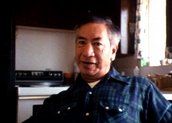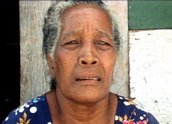


Half Life: A Parable for the Nuclear Age (1985)
Synopsis
From 1946 to 1958 the US used the Marshall Islands south of Hawaii to test nuclear weapons above ground. Early atom bomb tests were conducted with some caution, but later the US exploded hydrogen bombs that were much more powerful, and the people of the Marshall Islands and some American personnel were exposed to deadly levels of radiation. Half Life retraces the events that led to this human disaster and the consequences of ‘Operation Castle’ conducted on March 1 1954. The documentary incorporates newsreel footage, excerpts from American propaganda films of the time and other historical sources. It also includes filmed interviews with Rongelap and Rongerik Atoll inhabitants and American servicemen who were exposed to the fallout. Narrative commentary is presented in the form of extended intertitles.
Curator’s notes
Dennis O’Rourke has been making documentary films since the late 1970s and continues to be one of the country’s most provocative and engaging filmmakers. In Half Life he tackles the consequences of living in the post-Cold War nuclear age and the moral and ethical questions which emerge from societies driven by imperatives toward security and ‘progress’ at any cost. Specifically the film looks at the 1954 US nuclear test on the Marshall Islands, but that has resonances with other tests conducted around the world at the same time (see Operation Buffalo – Colour Record about the nuclear tests at Maralinga in South Australia).
Half Life opens with a speech by Einstein which foreshadows what is to come and ends with an unsettling television address by the then US President Reagan to the Marshallese people, wishing them the best for their future as a sovereign nation. The prompt for the documentary was the 1980s hearings in the US Congress, debating the amount of compensation that should be given to the Marshall Islanders for their suffering. Against this backdrop, O’Rourke presents the case that the US government knowingly used the Marshall Islands as a testing ground for new atomic weapons and to document the long-term effects of radiation on a population. He effectively incorporates excerpts from secret films and documents made by the US Atomic Energy Commission (AEC) to backup this argument. The film is packed full of historical information, transcripts from US official documents and film records that are placed within the political context of the Cold War fear and 1950s anti-Communist sentiment amongst the American population. Intertitles punctuate the film and act as explanatory notes in place of a full narrative voice-over. This increases the impact of the film by silently reinforcing the devastating effects of the bombings on the Marshallese population (see clip one).
What makes this film so engaging is O’Rourke’s careful crafting of the narrative, which builds up slowly and quietly with generous use of historical film footage of the blasts and the subsequent scientific follow-up. This is contextualised by images of present-day life on the islands and the personal accounts of Marshallese survivors from the Atolls of Rongelap and Rongerik (which were in the nuclear fallout zone). They speak candidly to the camera about their experiences (clip three). It is the personal testimony of the Marshallese survivors and their oral recounts of history that are the most affecting. This is O’Rourke’s strength as a filmmaker. Over his career, he has developed a style that builds trust with his subjects and presents their stories first-hand (see The Good Woman of Bangkok (1991) and Land Mines: A Love Story (2004)).
- Overview
- Curator’s notes
- Video 3 clips
- Principal credits
- Find a copy
- Make a comment
- Map
- Add your review



